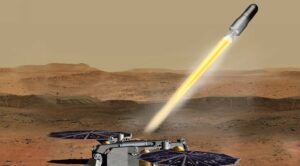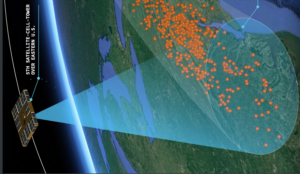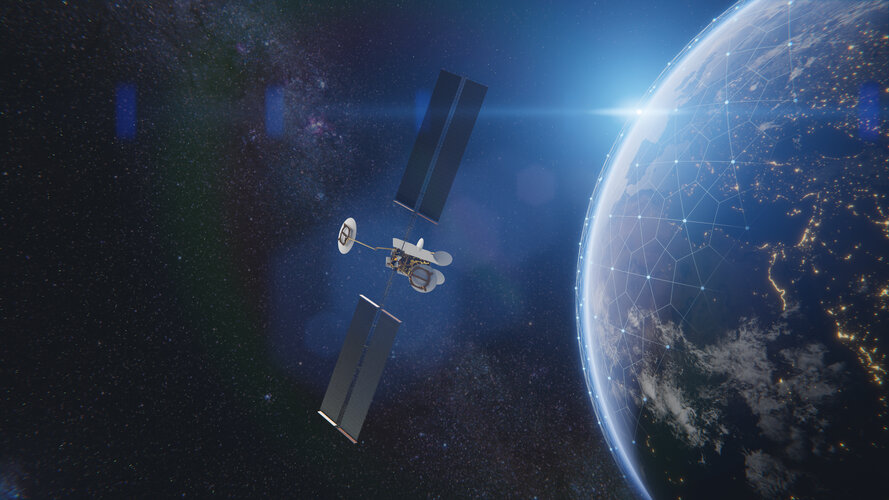Lockheed Martin wins contract to build rocket for Mars Sample Return
Tuesday, 08 February 2022 11:30
NASA has selected Lockheed Martin to build a small rocket that will transport samples collected by the Perseverance rover into orbit around Mars.
The post Lockheed Martin wins contract to build rocket for Mars Sample Return appeared first on SpaceNews.
Lynk satellites connect with thousands of devices
Tuesday, 08 February 2022 10:00
Lynk Global satellites have connected with thousands of unmodified smartphones, tablets, internet-of-things devices and vehicles, the Fall Church, Virginia, startup announced Feb. 8.
The post Lynk satellites connect with thousands of devices appeared first on SpaceNews.
ESA seeks software ideas to bring smart satellites to life
Tuesday, 08 February 2022 07:00
If we were to talk about our bodies in the technical terms that we typically use to talk about spacecraft, our bones, muscles and ligaments would be our 'hardware', our brain the 'central processing unit (CPU)', and our nervous system the 'software'.
Search is on for young space entrepreneurs ahead of first UK rocket launches
Tuesday, 08 February 2022 06:52 With Britain's first satellite launches set to take place this year, the SatelLife Competition is looking for the best new ideas for how to use data collected from space to benefit daily life, from supporting local communities and the NHS, to monitoring the environment and tackling climate change.
The competition is now in its fifth year, with previous winning ideas including drones carryi
With Britain's first satellite launches set to take place this year, the SatelLife Competition is looking for the best new ideas for how to use data collected from space to benefit daily life, from supporting local communities and the NHS, to monitoring the environment and tackling climate change.
The competition is now in its fifth year, with previous winning ideas including drones carryi UCF lands DOD award for advance hypersonic propulsion research
Tuesday, 08 February 2022 06:52 Anew race to harness hypersonic speed for travel and defense has started, and University of Central Florida researchers are helping the U.S. stay ahead of the pack with a new $1.5 million U.S. Department of Defense award to develop high-performance fuels for hypersonic propulsion.
The race, which includes competition from Russia and China, recently intensified when it was reported that Chi
Anew race to harness hypersonic speed for travel and defense has started, and University of Central Florida researchers are helping the U.S. stay ahead of the pack with a new $1.5 million U.S. Department of Defense award to develop high-performance fuels for hypersonic propulsion.
The race, which includes competition from Russia and China, recently intensified when it was reported that Chi Arianespace to serve OneWeb's ambitions, will orbit 34 additional satellites with Soyuz
Tuesday, 08 February 2022 06:52 After the successful launch of NASA's Webb Space Telescope on December 25 with Ariane 5, Arianespace is back to the Guiana Space Center (CSG) with Soyuz for a February 10 lift-off. The first Arianespace mission of the year will orbit 34 additional OneWeb satellites. With this mission, Arianespace will exceed 100 satellites launched on Soyuz from the CSG, while OneWeb's fleet will be brought to 4
After the successful launch of NASA's Webb Space Telescope on December 25 with Ariane 5, Arianespace is back to the Guiana Space Center (CSG) with Soyuz for a February 10 lift-off. The first Arianespace mission of the year will orbit 34 additional OneWeb satellites. With this mission, Arianespace will exceed 100 satellites launched on Soyuz from the CSG, while OneWeb's fleet will be brought to 4 Protons are probably actually smaller than long thought
Tuesday, 08 February 2022 06:52 A few years ago, a novel measurement technique showed that protons are probably smaller than had been assumed since the 1990s. The discrepancy surprised the scientific community; some researchers even believed that the Standard Model of particle physics would have to be changed.
Physicists at the University of Bonn and the Technical University of Darmstadt have now developed a method that
A few years ago, a novel measurement technique showed that protons are probably smaller than had been assumed since the 1990s. The discrepancy surprised the scientific community; some researchers even believed that the Standard Model of particle physics would have to be changed.
Physicists at the University of Bonn and the Technical University of Darmstadt have now developed a method that Researchers set record by preserving quantum states for more than 5 seconds
Tuesday, 08 February 2022 06:52Scientists develop exceptional surface to explore exotic physics
Tuesday, 08 February 2022 06:52 By demonstrating exceptional control of an open optical system, an international research team has provided a path to experimentally measure and test exotic phenomena and gain insights into new physics with exquisite sensitivity.
Reported in Nature Communications, the Penn State, Michigan Technological University and Vienna University of Technology researchers created a stable surface of '
By demonstrating exceptional control of an open optical system, an international research team has provided a path to experimentally measure and test exotic phenomena and gain insights into new physics with exquisite sensitivity.
Reported in Nature Communications, the Penn State, Michigan Technological University and Vienna University of Technology researchers created a stable surface of ' Collaborative research project on quantum technology starts on the International Space Station
Tuesday, 08 February 2022 06:52 In early December 2021, the project "Development of a laser system for experiments with Bose-Einstein condensates on the International Space Station within the BECCAL payload (BECCAL-II)" commenced, with the involvement of a team of researchers led by Professor Patrick Windpassinger and Dr. Andre Wenzlawski from Johannes Gutenberg University Mainz (JGU).
In collaboration with Humboldt-Univ
In early December 2021, the project "Development of a laser system for experiments with Bose-Einstein condensates on the International Space Station within the BECCAL payload (BECCAL-II)" commenced, with the involvement of a team of researchers led by Professor Patrick Windpassinger and Dr. Andre Wenzlawski from Johannes Gutenberg University Mainz (JGU).
In collaboration with Humboldt-Univ Tonga eruption sent ripples through Earth's ionosphere
Tuesday, 08 February 2022 06:52 The powerful underwater volcanic eruption that blanketed the island nation of Tonga with ash and sent tsunami waves across the world also caused ripples in Earth's ionosphere, according to measurements from the Global Differential Global Positioning System (GDGPS) managed by NASA's Jet Propulsion Laboratory in Southern California.
When the Hunga Tonga-Hunga Ha'apai volcano erupted on Jan.
The powerful underwater volcanic eruption that blanketed the island nation of Tonga with ash and sent tsunami waves across the world also caused ripples in Earth's ionosphere, according to measurements from the Global Differential Global Positioning System (GDGPS) managed by NASA's Jet Propulsion Laboratory in Southern California.
When the Hunga Tonga-Hunga Ha'apai volcano erupted on Jan. NASA selects developer for rocket to retrieve first samples from Mars
Tuesday, 08 February 2022 04:45 NASA has awarded a contract to Lockheed Martin Space of Littleton, Colorado, to build the Mars Ascent Vehicle (MAV), a small, lightweight rocket to launch rock, sediment, and atmospheric samples from the surface of the Red Planet. The award brings NASA a step closer to the first robotic round-trip to bring samples safely to Earth through the Mars Sample Return Program.
"This groundbreaking
NASA has awarded a contract to Lockheed Martin Space of Littleton, Colorado, to build the Mars Ascent Vehicle (MAV), a small, lightweight rocket to launch rock, sediment, and atmospheric samples from the surface of the Red Planet. The award brings NASA a step closer to the first robotic round-trip to bring samples safely to Earth through the Mars Sample Return Program.
"This groundbreaking Is the 'fine-tuned universe' an illusion?
Tuesday, 08 February 2022 04:45 For decades physicists have been perplexed about why our cosmos appears to have been precisely tuned to foster intelligent life. It is widely thought that if the values of certain physical parameters, such as the masses of elementary particles, were tweaked, even slightly, it would have prevented the formation of the components necessary for life in the universe - including planets, stars, and g
For decades physicists have been perplexed about why our cosmos appears to have been precisely tuned to foster intelligent life. It is widely thought that if the values of certain physical parameters, such as the masses of elementary particles, were tweaked, even slightly, it would have prevented the formation of the components necessary for life in the universe - including planets, stars, and g Chemical history of the Milky Way revealed by new catalog of tens of millions of stars
Tuesday, 08 February 2022 04:45 University of Notre Dame researchers, along with collaborators in China and Australia, published a new sample catalog of more than 24 million stars that can be used to decipher the chemical history of elements in the Milky Way Galaxy.
The research, published February 3 in The Astrophysical Journal, represents about one-hundredth of a percent of the roughly 240 billion stars in the Milky Wa
University of Notre Dame researchers, along with collaborators in China and Australia, published a new sample catalog of more than 24 million stars that can be used to decipher the chemical history of elements in the Milky Way Galaxy.
The research, published February 3 in The Astrophysical Journal, represents about one-hundredth of a percent of the roughly 240 billion stars in the Milky Wa Astra Space scrubs first Florida launch a second time
Tuesday, 08 February 2022 04:45 Astra Space postponed its first rocket launch from Florida on Monday for the second time in three days due to a "minor telemetry issue" and did not set a new launch date, a company official said.
"Unfortunately, we need to stand down from today's launch attempt," Astra product manager Carolina Grossman said during a live launch broadcast.
The rocket's software aborted a launch at
Astra Space postponed its first rocket launch from Florida on Monday for the second time in three days due to a "minor telemetry issue" and did not set a new launch date, a company official said.
"Unfortunately, we need to stand down from today's launch attempt," Astra product manager Carolina Grossman said during a live launch broadcast.
The rocket's software aborted a launch at 
